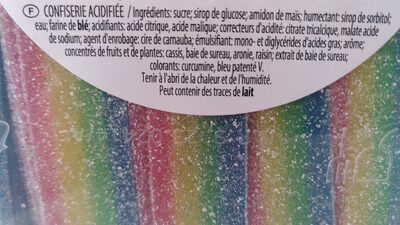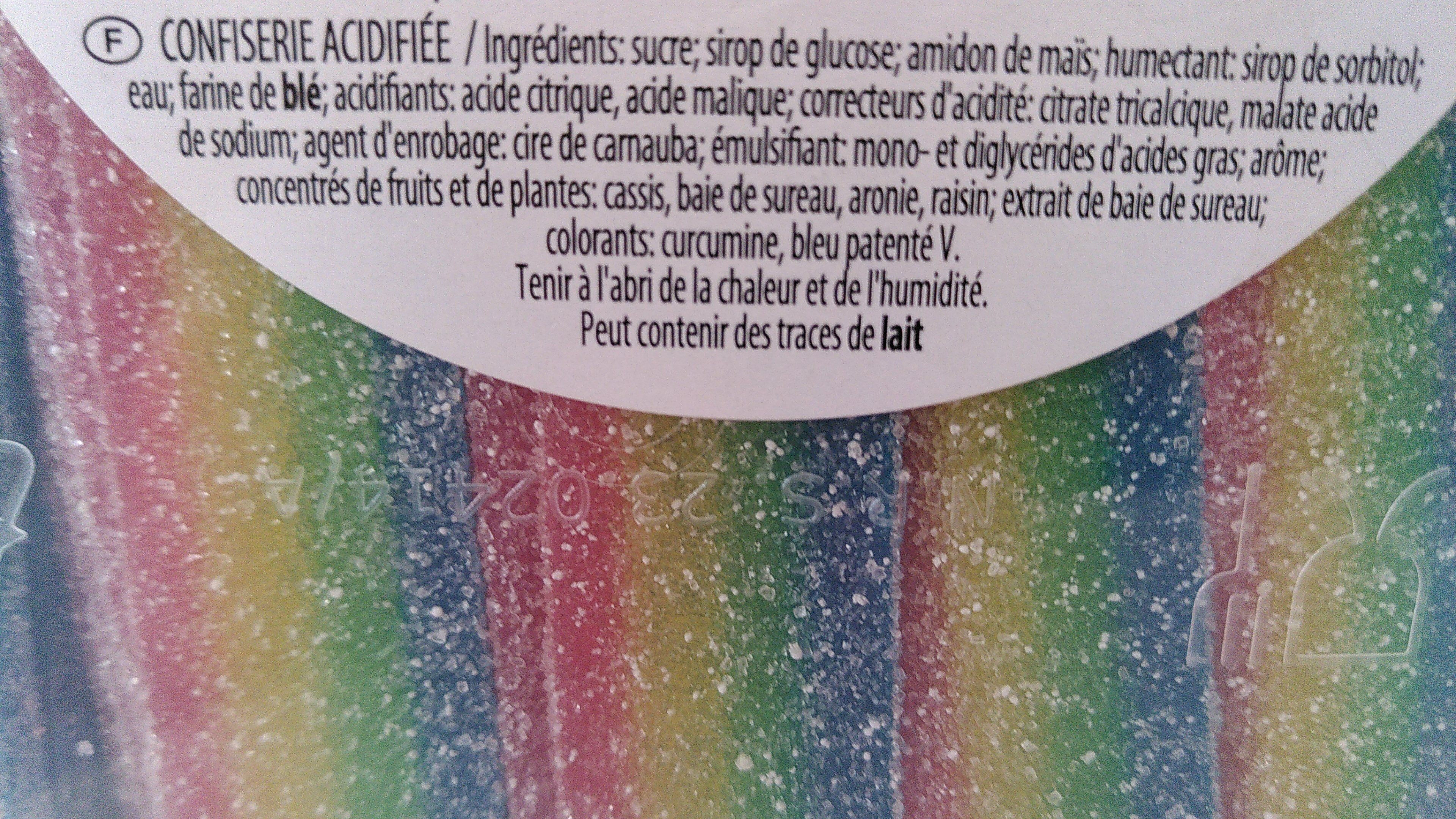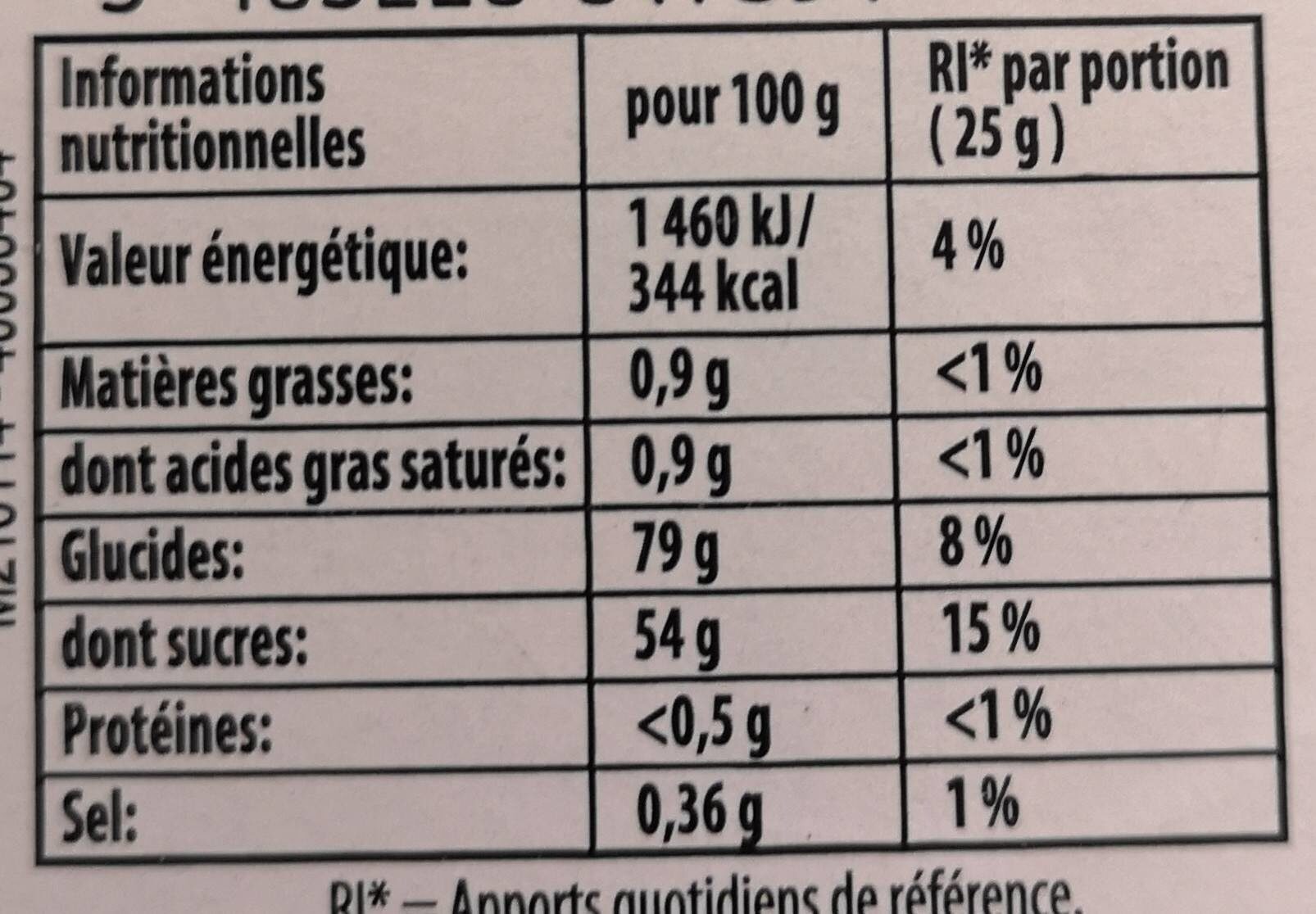Help us make food transparency the norm!
As a non-profit organization, we depend on your donations to continue informing consumers around the world about what they eat.
The food revolution starts with you!
Haribo pasta Basta Miami Pik - 1125g
Haribo pasta Basta Miami Pik - 1125g
This product page is not complete. You can help to complete it by editing it and adding more data from the photos we have, or by taking more photos using the app for Android or iPhone/iPad. Thank you!
×
Barcode: 3103220047354 (EAN / EAN-13)
Quantity: 1125g
Packaging: Plastic
Brands: Haribo
Categories: Snacks, Sweet snacks, Cocoa and its products, Confectioneries, Chocolate candies, Bonbons
Countries where sold: France
Matching with your preferences
Health
Ingredients
-
27 ingredients
: Sucre; sirop de glucose; amidon de mais; humectant: sirop de sorbitol); eau; farine de blé; acidifiants: acide citrique, acide malique; correcteurs d'acidité: citrate tricalcique, malate acide de sodium; agent d'enrobage: cire de carnauba; émulsifiant: mono - et diglycéides d'acides gras; arôme; concentrés de fruits et de plantes: cassis, baie de sureau, aronie, raisin; extrait de baie de sureau; colorants: curcumine, bleu patenté V.Allergens: GlutenTraces: Milk
Food processing
-
Ultra processed foods
Elements that indicate the product is in the 4 - Ultra processed food and drink products group:
- Additive: E100 - Curcumin
- Additive: E131 - Patent blue v
- Additive: E420 - Sorbitol
- Additive: E903 - Carnauba wax
- Ingredient: Colour
- Ingredient: Emulsifier
- Ingredient: Flavouring
- Ingredient: Glazing agent
- Ingredient: Glucose
- Ingredient: Glucose syrup
- Ingredient: Humectant
Food products are classified into 4 groups according to their degree of processing:
- Unprocessed or minimally processed foods
- Processed culinary ingredients
- Processed foods
- Ultra processed foods
The determination of the group is based on the category of the product and on the ingredients it contains.
Additives
-
E131 - Patent blue v
Patent Blue V: Patent Blue V, also called Food Blue 5, Sulphan Blue, Acid Blue 3, L-Blau 3, C-Blau 20, Patentblau V, Sky Blue, or C.I. 42051 and is a dark bluish synthetic triphenylmethane dye used as a food coloring. As a food additive, it has E number E131. It is a sodium or calcium salt of [4--α--4-diethylaminophenyl--5-hydroxy- 2‚4-disulfophenylmethylidene--2‚5-cyclohexadien-1-ylidene] diethylammonium hydroxide inner salt.Source: Wikipedia
-
E296 - Malic acid
Malic acid: Malic acid is an organic compound with the molecular formula C4H6O5. It is a dicarboxylic acid that is made by all living organisms, contributes to the pleasantly sour taste of fruits, and is used as a food additive. Malic acid has two stereoisomeric forms -L- and D-enantiomers-, though only the L-isomer exists naturally. The salts and esters of malic acid are known as malates. The malate anion is an intermediate in the citric acid cycle.Source: Wikipedia
-
E330 - Citric acid
Citric acid is a natural organic acid found in citrus fruits such as lemons, oranges, and limes.
It is widely used in the food industry as a flavor enhancer, acidulant, and preservative due to its tart and refreshing taste.
Citric acid is safe for consumption when used in moderation and is considered a generally recognized as safe (GRAS) food additive by regulatory agencies worldwide.
-
E333 - Calcium citrates
Calcium citrate: Calcium citrate is the calcium salt of citric acid. It is commonly used as a food additive -E333-, usually as a preservative, but sometimes for flavor. In this sense, it is similar to sodium citrate. Calcium citrate is also found in some dietary calcium supplements -e.g. Citracal-. Calcium makes up 24.1% of calcium citrate -anhydrous- and 21.1% of calcium citrate -tetrahydrate- by mass. The tetrahydrate occurs in nature as the mineral Earlandite.Source: Wikipedia
-
E333iii - Tricalcium citrate
Calcium citrate: Calcium citrate is the calcium salt of citric acid. It is commonly used as a food additive -E333-, usually as a preservative, but sometimes for flavor. In this sense, it is similar to sodium citrate. Calcium citrate is also found in some dietary calcium supplements -e.g. Citracal-. Calcium makes up 24.1% of calcium citrate -anhydrous- and 21.1% of calcium citrate -tetrahydrate- by mass. The tetrahydrate occurs in nature as the mineral Earlandite.Source: Wikipedia
-
E350 - Sodium malates
Sodium malate: Sodium malate is a compound with formula Na2-C2H4O-COO-2-. It is the sodium salt of malic acid. As a food additive, it has the E number E350.Source: Wikipedia
-
E350ii - Sodium hydrogen malate
Sodium malate: Sodium malate is a compound with formula Na2-C2H4O-COO-2-. It is the sodium salt of malic acid. As a food additive, it has the E number E350.Source: Wikipedia
-
E420 - Sorbitol
Sorbitol: Sorbitol --, less commonly known as glucitol --, is a sugar alcohol with a sweet taste which the human body metabolizes slowly. It can be obtained by reduction of glucose, which changes the aldehyde group to a hydroxyl group. Most sorbitol is made from corn syrup, but it is also found in nature, for example in apples, pears, peaches, and prunes. It is converted to fructose by sorbitol-6-phosphate 2-dehydrogenase. Sorbitol is an isomer of mannitol, another sugar alcohol; the two differ only in the orientation of the hydroxyl group on carbon 2. While similar, the two sugar alcohols have very different sources in nature, melting points, and uses.Source: Wikipedia
-
E420ii - Sorbitol syrup
Sorbitol: Sorbitol --, less commonly known as glucitol --, is a sugar alcohol with a sweet taste which the human body metabolizes slowly. It can be obtained by reduction of glucose, which changes the aldehyde group to a hydroxyl group. Most sorbitol is made from corn syrup, but it is also found in nature, for example in apples, pears, peaches, and prunes. It is converted to fructose by sorbitol-6-phosphate 2-dehydrogenase. Sorbitol is an isomer of mannitol, another sugar alcohol; the two differ only in the orientation of the hydroxyl group on carbon 2. While similar, the two sugar alcohols have very different sources in nature, melting points, and uses.Source: Wikipedia
-
E903 - Carnauba wax
Carnauba wax: Carnauba -; Portuguese: carnaúba [kaʁnɐˈubɐ]-, also called Brazil wax and palm wax, is a wax of the leaves of the palm Copernicia prunifera -Synonym: Copernicia cerifera-, a plant native to and grown only in the northeastern Brazilian states of Piauí, Ceará, Maranhão, Bahia, and Rio Grande do Norte. It is known as "queen of waxes" and in its pure state, usually comes in the form of hard yellow-brown flakes. It is obtained from the leaves of the carnauba palm by collecting and drying them, beating them to loosen the wax, then refining and bleaching the wax.Source: Wikipedia
Ingredients analysis
-
Palm oil free
No ingredients containing palm oil detected
Unrecognized ingredients: fr:mono-et-diglyceides-d-acides-grasSome ingredients could not be recognized.
We need your help!
You can help us recognize more ingredients and better analyze the list of ingredients for this product and others:
- Edit this product page to correct spelling mistakes in the ingredients list, and/or to remove ingredients in other languages and sentences that are not related to the ingredients.
- Add new entries, synonyms or translations to our multilingual lists of ingredients, ingredient processing methods, and labels.
If you would like to help, join the #ingredients channel on our Slack discussion space and/or learn about ingredients analysis on our wiki. Thank you!
-
Vegan status unknown
Unrecognized ingredients: fr:mono-et-diglyceides-d-acides-grasSome ingredients could not be recognized.
We need your help!
You can help us recognize more ingredients and better analyze the list of ingredients for this product and others:
- Edit this product page to correct spelling mistakes in the ingredients list, and/or to remove ingredients in other languages and sentences that are not related to the ingredients.
- Add new entries, synonyms or translations to our multilingual lists of ingredients, ingredient processing methods, and labels.
If you would like to help, join the #ingredients channel on our Slack discussion space and/or learn about ingredients analysis on our wiki. Thank you!
-
Vegetarian status unknown
Unrecognized ingredients: fr:mono-et-diglyceides-d-acides-grasSome ingredients could not be recognized.
We need your help!
You can help us recognize more ingredients and better analyze the list of ingredients for this product and others:
- Edit this product page to correct spelling mistakes in the ingredients list, and/or to remove ingredients in other languages and sentences that are not related to the ingredients.
- Add new entries, synonyms or translations to our multilingual lists of ingredients, ingredient processing methods, and labels.
If you would like to help, join the #ingredients channel on our Slack discussion space and/or learn about ingredients analysis on our wiki. Thank you!
-
Details of the analysis of the ingredients
We need your help!
Some ingredients could not be recognized.
We need your help!
You can help us recognize more ingredients and better analyze the list of ingredients for this product and others:
- Edit this product page to correct spelling mistakes in the ingredients list, and/or to remove ingredients in other languages and sentences that are not related to the ingredients.
- Add new entries, synonyms or translations to our multilingual lists of ingredients, ingredient processing methods, and labels.
If you would like to help, join the #ingredients channel on our Slack discussion space and/or learn about ingredients analysis on our wiki. Thank you!
: Sucre, sirop de glucose, amidon de mais, humectant (sirop de sorbitol), eau, farine de blé, acidifiants (acide citrique), acide malique, correcteurs d'acidité (citrate tricalcique), malate acide de sodium, agent d'enrobage (cire de carnauba), émulsifiant (mono- et diglycéides d'acides gras), arôme, concentrés de fruits et (cassis), baie de sureau, aronie, raisin, extrait de baie de sureau, colorants (curcumine), bleu patenté V- Sucre -> en:sugar - vegan: yes - vegetarian: yes - ciqual_proxy_food_code: 31016 - percent_min: 5 - percent_max: 100
- sirop de glucose -> en:glucose-syrup - vegan: yes - vegetarian: yes - ciqual_proxy_food_code: 31016 - percent_min: 0 - percent_max: 50
- amidon de mais -> en:corn-starch - vegan: yes - vegetarian: yes - ciqual_food_code: 9510 - percent_min: 0 - percent_max: 33.3333333333333
- humectant -> en:humectant - percent_min: 0 - percent_max: 25
- sirop de sorbitol -> en:e420ii - vegan: yes - vegetarian: yes - percent_min: 0 - percent_max: 25
- eau -> en:water - vegan: yes - vegetarian: yes - ciqual_food_code: 18066 - percent_min: 0 - percent_max: 20
- farine de blé -> en:wheat-flour - vegan: yes - vegetarian: yes - ciqual_proxy_food_code: 9410 - percent_min: 0 - percent_max: 16.6666666666667
- acidifiants -> en:acid - percent_min: 0 - percent_max: 14.2857142857143
- acide citrique -> en:e330 - vegan: yes - vegetarian: yes - percent_min: 0 - percent_max: 14.2857142857143
- acide malique -> en:e296 - vegan: yes - vegetarian: yes - percent_min: 0 - percent_max: 12.5
- correcteurs d'acidité -> en:acidity-regulator - percent_min: 0 - percent_max: 11.1111111111111
- citrate tricalcique -> en:e333 - vegan: yes - vegetarian: yes - percent_min: 0 - percent_max: 11.1111111111111
- malate acide de sodium -> en:e350ii - vegan: yes - vegetarian: yes - percent_min: 0 - percent_max: 10
- agent d'enrobage -> en:glazing-agent - percent_min: 0 - percent_max: 9.09090909090909
- cire de carnauba -> en:e903 - vegan: yes - vegetarian: yes - percent_min: 0 - percent_max: 9.09090909090909
- émulsifiant -> en:emulsifier - percent_min: 0 - percent_max: 8.33333333333333
- mono- et diglycéides d'acides gras -> fr:mono-et-diglyceides-d-acides-gras - percent_min: 0 - percent_max: 8.33333333333333
- arôme -> en:flavouring - vegan: maybe - vegetarian: maybe - percent_min: 0 - percent_max: 5
- concentrés de fruits et -> en:fruit-concentrate - labels: en:vegan - vegan: en:yes - vegetarian: en:yes - percent_min: 0 - percent_max: 5
- cassis -> en:blackcurrant - vegan: yes - vegetarian: yes - ciqual_food_code: 13007 - percent_min: 0 - percent_max: 5
- baie de sureau -> en:elderberry - vegan: yes - vegetarian: yes - ciqual_food_code: 13126 - percent_min: 0 - percent_max: 5
- aronie -> en:chokeberry - vegan: yes - vegetarian: yes - percent_min: 0 - percent_max: 5
- raisin -> en:grape - vegan: yes - vegetarian: yes - ciqual_food_code: 13112 - percent_min: 0 - percent_max: 5
- extrait de baie de sureau -> en:elderberry-extract - vegan: yes - vegetarian: yes - ciqual_food_code: 13126 - percent_min: 0 - percent_max: 5
- colorants -> en:colour - percent_min: 0 - percent_max: 5
- curcumine -> en:e100 - vegan: yes - vegetarian: yes - percent_min: 0 - percent_max: 5
- bleu patenté V -> en:e131 - vegan: yes - vegetarian: yes - percent_min: 0 - percent_max: 5
Nutrition
-
Poor nutritional quality
⚠ ️Warning: the amount of fruits, vegetables and nuts is not specified on the label, it was estimated from the list of ingredients: 0This product is not considered a beverage for the calculation of the Nutri-Score.
Positive points: 0
- Proteins: 0 / 5 (value: 0.5, rounded value: 0.5)
- Fiber: 0 / 5 (value: 0, rounded value: 0)
- Fruits, vegetables, nuts, and colza/walnut/olive oils: 0 / 5 (value: 0.0112342834472656, rounded value: 0)
Negative points: 15
- Energy: 4 / 10 (value: 1439, rounded value: 1439)
- Sugars: 10 / 10 (value: 54, rounded value: 54)
- Saturated fat: 0 / 10 (value: 0.9, rounded value: 0.9)
- Sodium: 1 / 10 (value: 144, rounded value: 144)
The points for proteins are not counted because the negative points are greater or equal to 11.
Nutritional score: (15 - 0)
Nutri-Score:
-
Nutrient levels
-
Fat in low quantity (0.9%)
What you need to know- A high consumption of fat, especially saturated fats, can raise cholesterol, which increases the risk of heart diseases.
Recommendation: Limit the consumption of fat and saturated fat- Choose products with lower fat and saturated fat content.
-
Saturated fat in low quantity (0.9%)
What you need to know- A high consumption of fat, especially saturated fats, can raise cholesterol, which increases the risk of heart diseases.
Recommendation: Limit the consumption of fat and saturated fat- Choose products with lower fat and saturated fat content.
-
Sugars in high quantity (54%)
What you need to know- A high consumption of sugar can cause weight gain and tooth decay. It also augments the risk of type 2 diabetes and cardio-vascular diseases.
Recommendation: Limit the consumption of sugar and sugary drinks- Sugary drinks (such as sodas, fruit beverages, and fruit juices and nectars) should be limited as much as possible (no more than 1 glass a day).
- Choose products with lower sugar content and reduce the consumption of products with added sugars.
-
Salt in moderate quantity (0.36%)
What you need to know- A high consumption of salt (or sodium) can cause raised blood pressure, which can increase the risk of heart disease and stroke.
- Many people who have high blood pressure do not know it, as there are often no symptoms.
- Most people consume too much salt (on average 9 to 12 grams per day), around twice the recommended maximum level of intake.
Recommendation: Limit the consumption of salt and salted food- Reduce the quantity of salt used when cooking, and don't salt again at the table.
- Limit the consumption of salty snacks and choose products with lower salt content.
-
-
Nutrition facts
Nutrition facts As sold
for 100 g / 100 mlAs sold
per serving (100g)Compared to: Bonbons Energy 1,439 kj
(344 kcal)1,440 kj
(344 kcal)-35% Fat 0.9 g 0.9 g -97% Saturated fat 0.9 g 0.9 g -95% Carbohydrates 79 g 79 g +51% Sugars 54 g 54 g +16% Fiber 0 g 0 g -100% Proteins 0.5 g 0.5 g -92% Salt 0.36 g 0.36 g +132% Fruits‚ vegetables‚ nuts and rapeseed‚ walnut and olive oils (estimate from ingredients list analysis) 0.011 % 0.011 %
Environment
-
Eco-Score not computed - Unknown environmental impact
We could not compute the Eco-Score of this product as it is missing some data, could you help complete it?Could you add a precise product category so that we can compute the Eco-Score? Add a category
Packaging
-
Packaging with a medium impact
-
Packaging parts
(Plastic)
-
Packaging materials
Material % Packaging weight Packaging weight per 100 g of product Plastic
-
Transportation
-
Origins of ingredients
Missing origins of ingredients information
⚠ ️ The origins of the ingredients of this product are not indicated.
If they are indicated on the packaging, you can modify the product sheet and add them.
If you are the manufacturer of this product, you can send us the information with our free platform for producers.Add the origins of ingredients for this product Add the origins of ingredients for this product
Report a problem
-
Incomplete or incorrect information?
Category, labels, ingredients, allergens, nutritional information, photos etc.
If the information does not match the information on the packaging, please complete or correct it. Open Food Facts is a collaborative database, and every contribution is useful for all.
Data sources
Product added on by kiliweb
Last edit of product page on by telperion87.
Product page also edited by charlesnepote, nicoolas, openfoodfacts-contributors, packbot, yuka.LJkbIoagD9wLLMHIgaY2_Du7Nr_5KvV7SX9Xog, yuka.sY2b0xO6T85zoF3NwEKvlkFiU_vuqS7bFEHnnWy2ncWCM7vaYo4uxZb4L6s.











